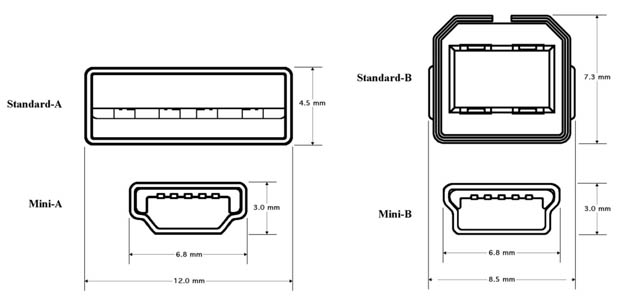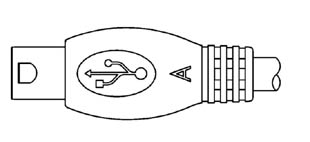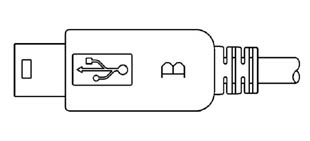 |
ARTICLES |
|
USB 2.0 On-The-Go |
New Connectors
One of the major mechanical enhancements to USB is the addition of new types of connectors. The effort to provide for smaller connectors better suited to portable devices began with an Engineering Change Notice to the core USB specification, which was released on October 20, 2000. That change notice added definitions for gMini-Bh plugs and receptacles, for use on peripheral devices.
The On-The-Go supplement adds definitions for "Mini-A" plugs and receptacles, for use on host devices, and a "Mini-AB" receptacle, which can be used on dual-role devices (devices which can function as either hosts or peripherals). These plugs and connectors are considerably smaller than their original, full-sized counterparts (see Figures 3).
 |
|
|
(a) Mini-A plug compared with Standard-A plug
|
(b) Mini-B plug compared with Standard-B plug
|
The most significant innovation in the new connectors is the Mini-AB receptacle. As previously mentioned, the original USB connectors are directed. This is an advantage, in that it makes it impossible to connect cables the wrong way. However, that paradigm would force a device that needs to operate both as a host and a device to have two connectors.
The new mini connectors are keyed so that they cannot be plugged in incorrectly. That is, a Mini-A plug will only fit a Mini-A receptacle, and in the correct orientation. Similarly, a Mini-B receptacle will only accept a Mini-B plug in the correct orientation. However, a Mini-AB receptacle can accept a Mini-B plug, for connecting to a host device, or a Mini-A plug, for connecting to a peripheral device. That is, the role of a device with a Mini-AB receptacle is defined by the type of cable that is connected to it (see Figure 4).
 |
 |
|
(a) Mini-A plug
|
(b) Mini-b plug
|
The new mini plugs and receptacles have five contacts, while the full-sized A and B plugs and receptacles have four. The additional contact is an ID pin, which is used by a device with a Mini-AB receptacle to electrically determine whether the cable plugged into it has a Mini-A or Mini-B plug. The ID pin on a Mini-A plug is connected to ground with a resistance of less than 10 ohm ; on a Mini-B plug, the ID pin is unconnected.
The new connectors are also designed with new usability features. New visual clues have been provided to make it easier for the user to understand which end of the cable should plug where. One such clue is the color of the plastic inside the connector itself. The Mini-A plug and receptacle must use white plastic inside; the Mini-B connectors use black plastic, and the Mini-AB receptacle plastic must be gray. The plastic overmold on the plugs is also specified to be different; Mini-B plugs use a rectangular overmold, while Mini-A plugs use an elliptical overmold. The overmold shape is also echoed in the area where the USB icon is molded into the plastic. The plugs are also marked with "A" and "B" to further distinguish them. See Figure 6 for examples.
Finally, the new connectors have higher durability requirements, since cables on portable devices are likely to be plugged in and out much more frequently than those on desktop machines. Full-sized connectors are rated for 1500 insertion/extraction cycles; the new mini connectors are rated for 5000 cycles.
Copyright(C) 1996-2002 CQ Publishing Co., Ltd.